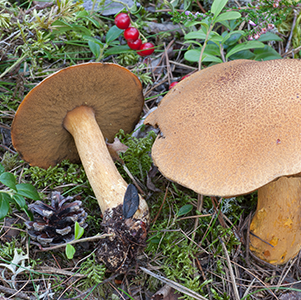Contact
anders.dahlberg@slu.se, 018-671598, 070-3502745

Saving standing trees after harvest is not only a boon to bird life; it also protects the ability of the soil to raise new generations of forest. A new study from SLU shows that a clear cut without retained trees can eradicate some 75 % of the mycorrhizal species of the soil. These are essential to the trees, and it is not given that it is the most important ones that survive or are able to re-establish.
All trees are dependent on mutualistic symbioses with mycorrhizal fungi to take up water and nutrients, and the boreal forests of Sweden are no exception. This makes the wellbeing of our forests mycorrhizal fungal communities essential to the future productivity of the soil. However, since the fungi are also dependent on the trees, the even-aged monocultural forests of industrial forestry has significantly affected mycorrhizal species.
Clear cutting is regarded the main reason forest species are red listed, and mycorrhizal fungi belong to those affected the hardest. For conservation reasons, a part of the trees are commonly retained at harvest, in Sweden usually 5-10 %. However, research on the effects that differing amounts of retention trees has on fungal communities has been lacking.
In a study from the Department of Forest Mycology and Plant Pathology and the Department of Soil and Environment at SLU, it is shown that the locally most abundant mycorrhizal species remain in the soil even when only a few trees are retained, but in less abundance. The less common mycorrhizal species, however, risk local elimination, and the risk increases the less trees remain. Professor Anders Dahlberg has been the project leader.
- We conducted an experiment in a pine forest north of the Arctic Circle, where we compared the fungal community in the soil in stands with 0, 30, 60 or 100 % retention trees respectively. The trial went on for three years.
The results show that if at least 30 % of the trees are retained, mycorrhizal fungi may three years later be found in more than 80 % of the soil samples. But if no trees are left, this frequency drops to roughly 50 %. The abundance of mycorrhiza in the fungal community at large dropped by 95 %, and the diversity of mycorrhizal species dropped by 75 %. The surviving ones probably lived on young pine seedlings. Fewer retention trees also meant an increased risk for locally rare species to disappear entirely.
The environmental organization Forest Stewardship Council in Sweden presently recommends 5 % retention trees at harvest. Anders Dahlberg has estimated the effect of such a practice based on his findings.
- If we retain 5 % of the trees, we will lose approximatively 75 % of all mycorrhizal species in the local stand. But already limited operations, such as 60 % retention trees, infer a loss of 30 % of the mycorrhizal species. These species are hard to replace. It has been estimated that it takes on average 90 years for a site to regain pre-harvest mycorrhizal biodiversity after a clear cut, but some species appear to not reestablish at all.
The most abundant mycorrhizal species decrease in relation to the whole fungal community, but are not eradicated, according to the study. However, many of the less abundant species that do disappear may be ecologically important, and they might ever reestablish, according to Anders Dahlberg.
In conclusion, the study shows that retention trees has a high value to the mycorrhizal community; both in species diversity and in abundance. Rare species may however disappear from a site altogether and subsequently be hard to replace.
- This shows the importance of protecting rare mycorrhizal species in ecologically important or fragile forests. Frequently retaining trees at harvest may be a viable method, Anders concludes.
Written på Mårten Lind
anders.dahlberg@slu.se, 018-671598, 070-3502745
Read the full story here: https://besjournals.onlinelibrary.wiley.com/doi/epdf/10.1111/1365-2664.13363